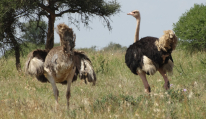Social Structure
Ostriches live in herds of no more than 12 birds. Each herd has a dominant male and female.
Behavior
Ostriches often congregate with herbivores to the mutual benefit of both groups: The grazing herbivores stir up insects, and the long-necked ostriches warn of approaching predators.
Diet
Ostriches are omnivorous. They eat plants, roots, seeds, insects, lizards, and whatever else they can find in their harsh, dry habitat. The toothless birds swallow pebbles with their food to help the gizzard—a muscular part of the stomach—grind up the food so it can be digested.
Breeding
An alpha male maintains his herd and mates with the herd’s dominant hen. But sometimes the alpha male mates with lesser hens, as may some other males. All the hens put their eggs in the nest of the dominant hen. She and the alpha male take turns incubating the eggs, each of which can weigh as much as three pounds (1.4 kg). The eggs incubate for 35 to 45 days. The chicks can run as soon as they hatch.
Population in Kenya
Ostriches inhabit much of Kenya in savanna, bush, and scrub.
Range & Habitat
Ostriches live throughout Africa on semiarid plains and woodlands.















